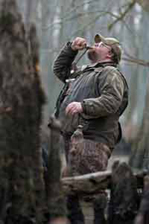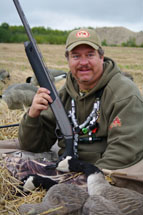Why You Should Go Bottoms Up
Feeder decoys add an extra degree of realism to your spread
Feeder decoys add an extra degree of realism to your spread

By Chris Jennings
Feeder-style decoys are not a new tool in the duck hunter's arsenal. In fact, waterfowling historians believe that floating feeders were among the first decoys used by early American waterfowlers. But today's decoy manufacturers have taken realism to the extreme, offering an array of feeder decoys in a variety of lifelike postures. Here are some useful tips from three veteran waterfowlers on how to use these decoys to bag more birds:

When hunting flooded timber, especially on public land in Arkansas, realism is a must. RNT-V producer Jim Ronquest relies on feeder decoys to set his spread apart from the crowd.
"I like to use them because they provide a different look and feel to my decoys," Ronquest explains. "But my favorite thing to do with them is to put them on a jerk cord. I like the way they move water."
For ducks looking down through the tree branches, moving water is an indication of ducks feeding below. The way feeder decoys displace water even with a slight twitch of the jerk cord can be a big draw for working ducks.
"If I am using two or three dozen decoys, a dozen of them will be GHG Pro-Grade Butt-Up feeders," Ronquest says. "In the timber, ducks are used to seeing two dozen regular mallard decoys, so I mix in mallard and black duck feeders to give my spread a different look."
 Thirty-year veteran waterfowler and Final Approach pro-staffer John Vaca uses what he refers to as a "match-the-hatch" strategy when setting his decoys. In other words, he strives to make his decoy spread closely imitate the waterfowl behavior he observes in the field. This approach relies heavily on scouting and knowledge of waterfowl behavior.
Thirty-year veteran waterfowler and Final Approach pro-staffer John Vaca uses what he refers to as a "match-the-hatch" strategy when setting his decoys. In other words, he strives to make his decoy spread closely imitate the waterfowl behavior he observes in the field. This approach relies heavily on scouting and knowledge of waterfowl behavior.
"I don't like to do the same thing every day with my decoys," Vaca says. "When I'm out scouting and I see ducks or geese feeding and dabbling in shallow water, I try to reproduce that activity by adding feeder decoys to my spread."
But hunters shouldn't use feeder decoys everywhere, cautions Vaca. "I've seen guys try to use feeder decoys where they really shouldn't," he says. "Throwing several duck butts out in deep water may not work if you are hunting local birds that know the area."
Even in ideal situations, Vaca prefers to rig his feeder decoys on a jerk string or some other method that creates decoy movement. "Watching ducks and geese tipping to feed, you'll see a lot of water moving around them," he says. "Adding that little bit of realism to your feeder decoys can be the difference between finishing birds or not."
 In northwest Missouri, Tony Vandemore uses feeder decoys to hunt moist-soil units and flooded agricultural fields on intensively managed private land. "I use them every day, and feel they benefit me every day," Vandemore says. "The biggest benefit is they are very realistic-you always see ducks skimming the surface and feeding with their butts up in the air."
In northwest Missouri, Tony Vandemore uses feeder decoys to hunt moist-soil units and flooded agricultural fields on intensively managed private land. "I use them every day, and feel they benefit me every day," Vandemore says. "The biggest benefit is they are very realistic-you always see ducks skimming the surface and feeding with their butts up in the air."
Vandemore believes that diversity is the key to his decoy spread's success. "The more different poses you have, the more realistic your decoy spread looks," he says. "Getting away from the cookie-cutter spread consisting of identical decoys will make your decoys more effective."
Like Vaca, Vandemore watches local waterfowl while they feed and then sets his decoys to imitate their natural behavior. He randomly mixes feeders, along with "active" and "rester" decoys, throughout his spread to mimic a flock that is relaxed and feeding naturally.
"I use Greenhead Gear Butt-Up, No-Head, and Surface Skimmer feeders," he explains. "If you watch a flock of ducks on the water from a distance, some are swimming, some are preening, and some are tipping up here and there. The more variety in body positions the better."
Ducks Unlimited uses cookies to enhance your browsing experience, optimize site functionality, analyze traffic, and deliver personalized advertising through third parties. By continuing to use this site, you agree to our use of cookies. View Privacy Policy